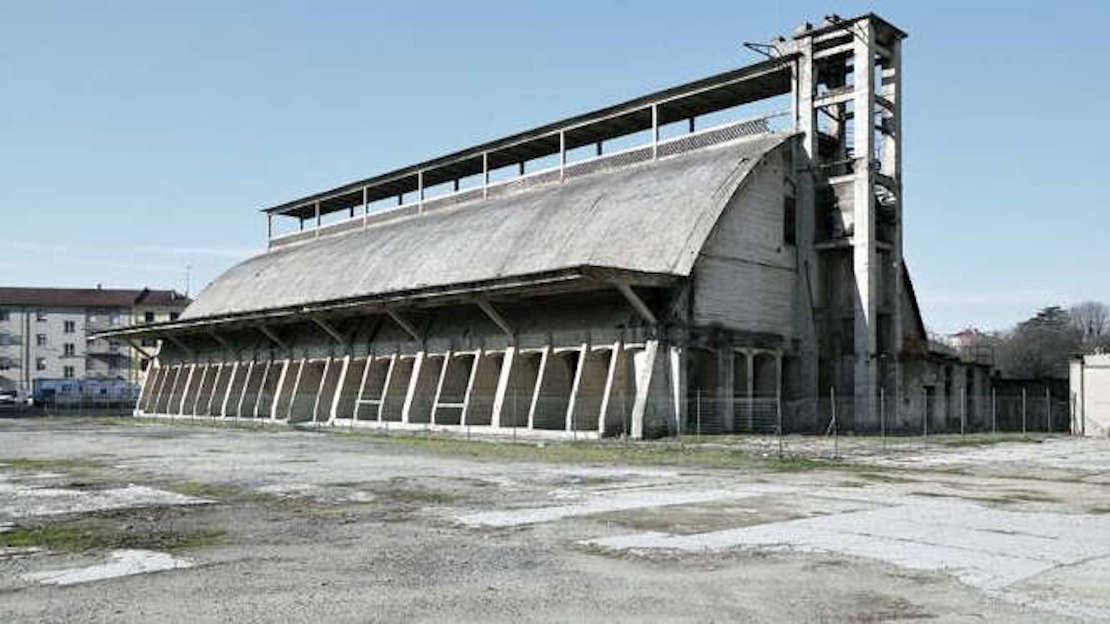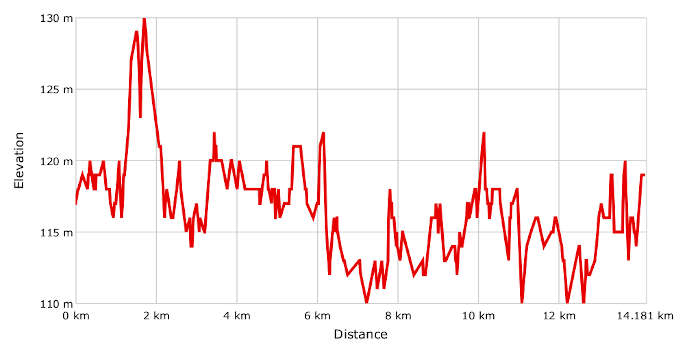
- Bike: famiglia/strada/trekking/mtb
- Difficulty: *
- Distance: 14 km
- Altitude difference: 20 m
- Total ascent: 76 m
- Total descent: 74 m

The idea of drawing up a cycle route dedicated to the industrial history of Casale Monferrato came from Legambiente and FIAB Monferrato, with sponsorship from Casale municipal council and the Po natural park and the invaluable knowledge of the association Il Cemento nell'Identità del Monferrato Casalese. The aim is to look at the town from an original perspective, enjoying a leisurely bike ride within everyone’s capabilities, following traces of history and the changes that have shaped Casale over the end of the 19th century and the 20th, in the age of the birth and development of the industrial economy.
In 1900, Casale Monferrato was the lime and cement capital of Italy. It was the first Italian town to begin industrially producing cement, thanks to the wealth and quality of Monferrato marl, which can be used to make natural cement without correctives. The cement works were built in the town near the hills from which the prized marl was quarried. From that time, the town of Casale Monferrato expanded to create new areas for production. The Oltreponte district came into being next to the production sites along the road for Turin, as did the new businesses on the industrial estate close to the railway station. This is not to mention the town's relationship to the river Po, along which different forms of manufacturing have thrived. Then there’s the recent rediscovery of the area as a place for sport and leisure and getting back in touch with nature. The route is just 14 km long and features 10 vantage points that trace the various industrial stages of the town, past capital of Monferrato and now one of Piedmont’s most important towns.
Start from the castle of the Paleologi in the town centre, where you’ll find a large car park. Head towards the Ronzone district, which was once an important location in industrial cement production. Come to the first vantage point, on Via XX Settembre, which was once known as Via dei Cementi. Right at the start of it you can see the first buildings on the left with references, above all on the front doors, to the presence of the local cement works’ administrative offices. Travel the length of the road to Via Aristide Oggero, named after a lawyer and member of parliament from 1874, as well as the mayor of Casale Monferrato. Pass Canale Lanza and you'll find the great Parco Eternot, the second vantage point. It’s a decontaminated area and historic location, once home to the Eternit works, which made asbestos cement products over 80 years of activity and is now remembered with sadness because of the connection with the many victims of asbestos in the town. The area was also home to the town’s great cement works, those which led the whole country for more than a century. The route continues by returning to Via XX Settembre and continues to the stop at the third vantage point, the former water lifting station of Consorzio Valentino e San Germano on the banks of Canale Lanza. This historic structure was built at the end of the 19th century and comprises a large pavilion with visible load-bearing brickwork and several floors inside. The ground/raised floor contains the rooms for civil use (previously the caretaker’s accommodation) and a storage room and former administrative offices. The cellar contains the lifting system, basically comprising turbines and pumps fixed to dedicated bases, while the attic floor has the tank to collect the water lifted, which it channels to the aqueduct, linked to the south side of the building at that level. The aqueduct is supported by many round arches, is made entirely of load-bearing brickwork and adjoins the building with access from the attic floor. The building is flanked to the east and west by a further two brickwork tanks equal in length to the building, positioned at the same level as the cellar section, and connected to it through some openings. Carry on straight for Via G. Cerrano until, a few metres from the crossroads on Via Sant’Anna, a foot and cycle path takes you beneath the bridge over Canale Lanza to proceed on Via G. Matteotti as far as the Via B. Buozzi roundabout. In the middle is the fourth vantage point, the historic cement kiln of the company Buzzi-Unicem. The route continues on Viale Ottavio Marchino (1883–1943), named after a cement industrialist who took his business nationwide. The fifth stopping point awaits us here. The Furnasetta is a 20 m-tall architectural landmark that is well preserved and can be seen from the road. It is now owned by Buzzi-Unicem. It was a vertical kiln, built in 1872 by Luigi Marchino to produce hydraulic lime then adapted to produce Portland natural cement in 1912, with patent courtesy of Giovanni Sisto Eccettuato. Proceed into Piazza degli Alpini, Via San Giovanni Bosco, then turn left onto Corso Valentino, following the cycle paths to the roundabout, and then turn onto Via Luigi Buzzi for the sixth point, the new headquarters of Buzzi-Unicem, a national cement industry giant. As you turn right onto Via Visconti for Via Padre Pio, you see a large abandoned building. This is the seventh stopping point, the Paraboloide. The structure of the Paraboloide gives full expression to the potential of reinforced concrete, which was recognised as one of the most important discoveries in structural engineering at the start of the last century. It allowed engineers to overcome the previously insuperable limits of so-called ‘heavy’ (i.e. stone or brick) structures in terms of both structural span and height, and to achieve the characteristic slenderness of metal structures. Continue along the route. On the right of Via Padre Pio you can see a large building. The eighth vantage point looks onto the former general warehouses of the Eternit company. Now completely decontaminated, these are now home to the Cittadella Trade Fair Centre, with bars and cinema screens.
As the route continues, the industrial character changes, switching from the great cement works of the end of the 19th century to the more recent refrigeration industry, which in Monferrato began in 1945. A farmer decided to experiment with a primitive cold room, cooled by two compressors purchased from the US army, for storing meat. It was a success, and led to the first company in the sector being founded in Casale Monferrato, Franger Frigor S.r.l., which initially operated only on the local market. In 1947, Franger started to dominate the market in Turin and Milan and in the following years became an S.p.A., or joint-stock company, with constant capital growth until 1957, when it achieved peaks of 110% a year in turnover growth. Mondial Frigor S.r.l. was founded in 1957 and became one of the most active companies on the market. At the start of the 1960s, the refrigeration industry expanded with the emergence of other companies, and in 1976 the Centro Studi Galileo launched the 'Casale Monferrato Capitale del Freddo' ('Casale Monferrato, Refrigeration Capital') project. The refrigeration industry district is now made up of large companies that play a leading role in the sector – also internationally – and a series of smaller and mostly family businesses. From the Porta Milano district, pass the cemetery, go alongside it on Via G. Rossa and enter the town’s industrial area. Keep left on Via A. Grandi and then on Via F. Negri. To symbolise the many local refrigeration companies, stop at the ninth point. On the left, at the end of a path, you can see the elegant premises of IARP Italy, a company founded in the town in 1983 which assumed immediate leadership in the market by producing refrigerated display units for the best-known brands in ice cream. The industrial route continues through the city along the GPX track to the bridge over the river Po to the Oltreponte district. A large structure was built here after the war to lend continuity to the publisher Casa Editrice Marietti, which was forced to interrupt publishing after bombing in 1942 during the war in Turin. At the start of the 1980s the company was embroiled in a profound crisis in terms of finance and direction. The family moved on, but without abandoning publishing; Pietro, Annibale’s son, founded Edizioni Piemme in 1983, transferred to the Mondadori Group in 2007. The property is still empty and its disrepair a sign of the industrial crisis. Here, in Via O. Frailich, is the tenth vantage point. You can go around the whole district to observe its industrial phases, from the post-war boom to the crisis of the new millennium. The route ends by crossing the river Po again in the direction of the starting point, the castle of the Paleologi.
